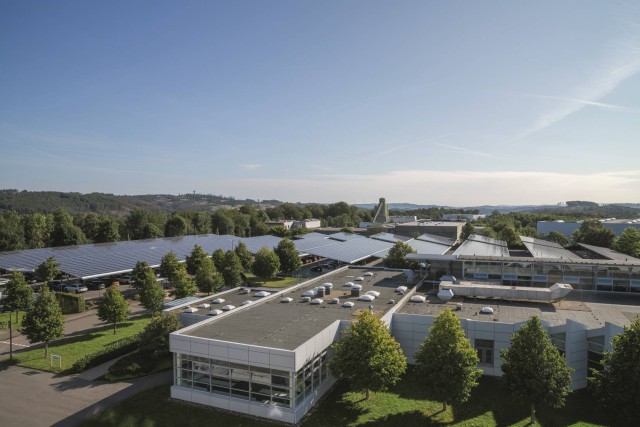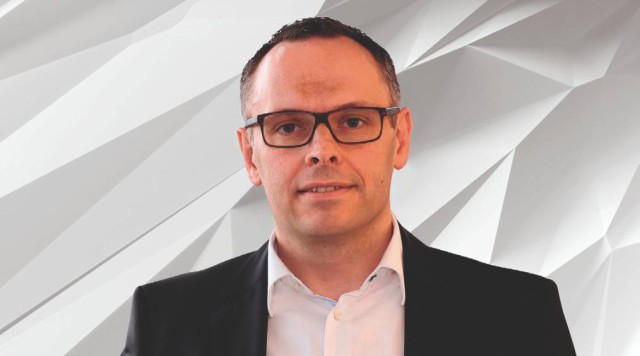Smart buildings are the building blocks to smarter communities

Giving building managers the power to make informed, data-driven decisions that reduce CO2 emissions, optimise energy efficiency and create a more sustainable world, says Dr. Thorsten Müller, Head of Global Product Group: Building and Home Automation Solutions at ABB
The buildings we live and work in – from industrial and commercial infrastructure such as factories and offices to private homes – are widely accepted as one of the biggest contributors to climate change and environmental challenges of our time.
The International Energy Agency (IEA) estimates that buildings and buildings construction sectors combined account for almost one-third of total global final energy consumption and nearly 15 percent of direct CO2 emissions1. It also identifies buildings as a source of enormous untapped efficiency potential.
Integrating smart technology into new builds and retrofitting existing sites is key to unlocking that potential, and to keeping alive hopes of limiting global temperature rise to 1.5°C this century in line with global treaties such as the Glasgow Climate Pact and the landmark 2015 Paris Agreement.
A smart move
Decarbonizing buildings is being driven not just through legislative forces, but also a collective understanding of the urgency to make the shifts we need in the fight against climate change.
Tackling the emissions challenge is two-fold – we need to both reduce the amount of energy used overall, and also replace much of the energy that we do use with renewables. Whether the challenge is integrated solar power, or reducing overall consumption, smart technology and data analysis is crucial. For this reason, the scope of work for a carbon-neutral building project is typically include a combination of both digital and automation solutions, and distributed energy resources.
Smart buildings deploy interconnected technologies to improve comfort and performance across key metrics like energy management, water use, air conditioning, access, automation, lighting, remote monitoring, and communication networks. Artificial intelligence (AI) for adaptable buildings that helps optimize data collected by smart internet of things (IoT) devices is one such innovation, as are touch-free interfaces that directly address the need for enhanced hygiene in the wake of Covid-19.
Heating, ventilation and air-conditioning (HVAC) and lighting, for example, account for about 50 percent of energy use in an average commercial building. More effective and efficient use of power can quickly repay an initial outlay on technology.
A smart system may cost around $37,500 to install, but if it delivers an energy cost savings of 25 percent, annual savings could be around $23,000 a year. This means that the system pays for itself in less than two years. By incorporating smart automation, managers may see energy costs fall by between 30 percent and 50 percent3.
Smart building systems combine HVAC in one holistic solution, from central control and management of heating and cooling systems down to room-level automation. They can simplify the implementation of intelligent automation in modern buildings and using pre-installed algorithms, can make autonomous decisions on functions like adjusting lighting and HVAC levels, to reflect time of day, external environment, occupancy levels or other variables.
Distributed energy sources in carbon-neutral buildings, meanwhile, include on-site photovoltaic (PV) technology, electric vehicle chargers, energy storage solutions, motors and drives, and power supply.
Steps to decarbonization
I’m often asked what a carbon neutral site actually looks like. Where does an organization start on its journey to decarbonization? What do digital and automation systems actually do?
To answer some of these questions, it is first important to outline the biggest steps to achieving carbon neutrality4. The first step is to deploy digital solutions and energy management such as monitoring, control and optimization, which are at the core of decarbonizing buildings. Next is to increase energy efficiency; utilizing building management systems and more efficient motors and drives, for instance.
Maximizing electrification using solutions such as heat-pumps and electric vehicle chargers as a third step is also important. The installation of renewable energy solutions should also feature in a low-carbon strategy, from PV technology and wind turbines to battery and thermal energy storage. The final step involves procuring renewable energy from the grid to offset any remaining emissions.
Carbon-neutral operations at Lüdenscheid and Porvoo
Two ground-breaking proof-of-concept projects from our own buildings in Germany and Finland demonstrate how solutions such as these can be successfully deployed to run a 100 percent carbon-neutral industrial facility. These buildings then create a blueprint, enabling us to take our tried and tested learning to our customers.
Our flagship factory in Lüdenscheid, western Germany, uses a combination of solar power, smart energy management and a highly efficient cogeneration plant to save large amounts of CO25. On sunny days it powers 100 percent of the factory’s power requirements and has reduced annual CO2 emissions by 744 tonnes. Whenever the on-site solutions can’t cover a peak in demand, green energy is sourced from MVV Energie AG, which guarantees 100 percent CO2-neutral production.
The Lüdenscheid plant manufactures products for electrical installation and is powered by around 7,300m2 of PV solar panels. The factory delivered approximately 1,190MWh of climate-neutral solar power in its first year alone, enough to meet the annual requirements of 360 private households. The co-generation plant has double the energy efficiency of a traditional coal-fired power plant.
The technological centrepiece of the system at Lüdenscheid is the digital energy management system. This system offers constant surveillance and optimum control of energy production, consumption and storage, and operates autonomously. This learning system calculates the optimum energy flow based on predictive data and compensates for deviations in real time.

At Lüdenscheid, ABB has also integrated a battery energy storage system (BESS) with an output of 200kW and a capacity of 275 kWh, electric vehicle charging points, and smart switchgear for efficient energy distribution.
ABB’s facility in Porvoo, Finland, which produces wiring accessories and installation materials for the smart buildings market in the Nordics, is now also carbon-neutral, utilizing 100 percent renewable energy6.
Porvoo is the first ABB site to recycle energy from its factory production. In its first year in operation, energy efficiency at Porvoo increased by 21 percent, while CO2 emissions decreased by 636 tonnes. This CO2 reduction is equivalent to driving the length of the equator 112 times or warming an electric sauna every day for 373 years.
Lüdenscheid and Porvoo, in addition to other sites in the Netherlands and China, represent our ‘Mission to Zero’ programme, part of our own journey towards carbon neutrality.
The power of together
There is increasing recognition that to address the climate crisis, organizations along the entire value chain cannot afford to work in isolation. No single company, public or private, can have a complete view of the entire energy landscape; instead, collaboration, the sharing of skills and knowledge – both business-to-business and business-to-consumer – is increasingly important to enact positive societal change.
In this context, digitalization enables buildings to provide value-adding services towards the modern energy grid – our Lüdenscheid factory can generate around 14 percent more energy than it needs, with any surplus fed into the public grid. Digitalization also supports the shift from ‘consumer’ to ‘prosumer’, facilitating concepts such as virtual power plants and maximizing the value of distributed energy resources on a broader scale.
Thanks to smart building solutions, operators and facility managers now have digital control of all facets of buildings from energy management, water use and air conditioning to access, automation, lighting, remote monitoring, and communication networks.
Web-based platforms allow the facility systems to integrate seamlessly with each other, delivering a single view of how effectively a building operates. Armed with this data, managers can then make informed decisions to avoid waste and improve use, contributing to CO2 reduction targets through efficiency gains in heating and cooling equipment, and within the building itself.
A sustainable future, one that moves us towards a low-carbon society and preserves the world’s resources, is critical for the health of the planet and all that inhabit it. Smart buildings have a vital role to play in reducing energy usage and emissions – and in creating a cleaner, safer society for all.
Sources
1 https://www.iea.org/topics/buildings
2 https://www.abb-conversations.com/2022/02/combining-bricks-and-bytes-for-a-safer-sustainable-future/
4 Anatomy of a Decarbonized Building – Blog
6 Porvoo Case Study
Dr. Thorsten Müller is Head of Global Product Group Building and Home Automation Solutions at ABB







